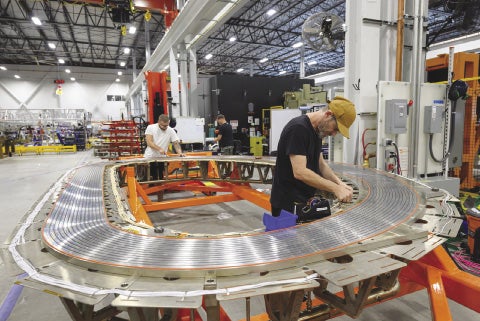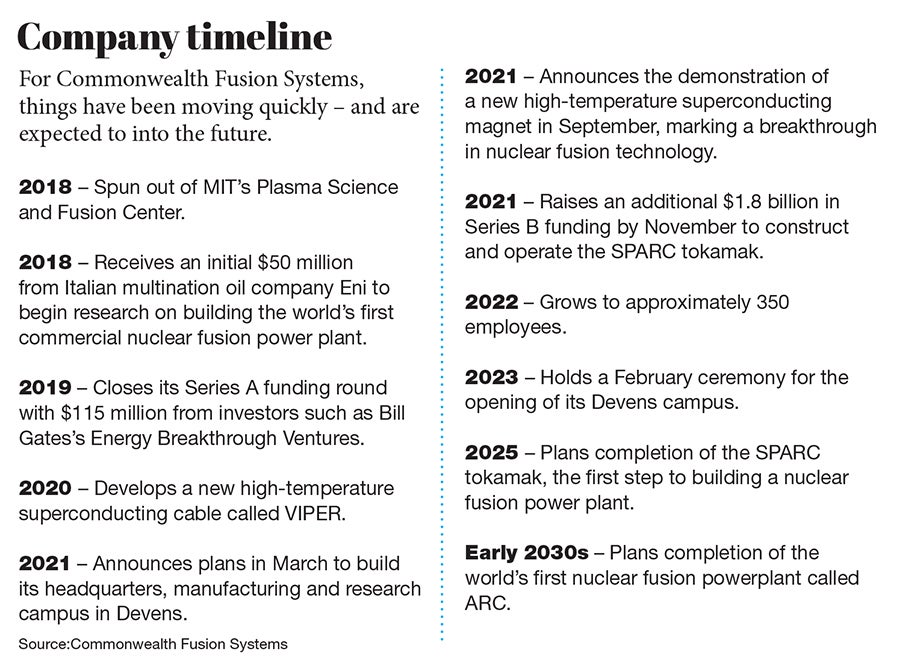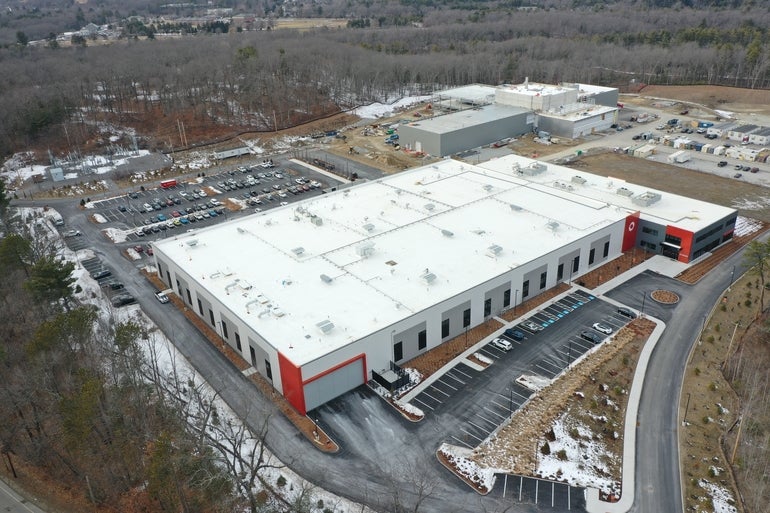While the prospect of commercial nuclear fusion energy in just 10 years may seem ambitious, one Devens-based company is working to make it a reality.
Get Instant Access to This Article
Subscribe to Worcester Business Journal and get immediate access to all of our subscriber-only content and much more.
- Critical Central Massachusetts business news updated daily.
- Immediate access to all subscriber-only content on our website.
- Bi-weekly print or digital editions of our award-winning publication.
- Special bonus issues like the WBJ Book of Lists.
- Exclusive ticket prize draws for our in-person events.
Click here to purchase a paywall bypass link for this article.
The year is 2034 and a revolutionary new type of energy source is helping to power Massachusetts households from Boston to Stockbridge.
While the prospect of commercial nuclear fusion energy in just 10 years may seem ambitious, one Devens-based company is working to make it a reality.
Commonwealth Fusion Systems is spearheading breakthroughs to transition nuclear fusion from isolated lab experiments to a widespread commercial power source. The company was founded in 2018 and spun out of MIT's Plasma Science and Fusion Center with the goal of bringing decades of academic research into the private sector.
The company received nearly $2 billion in Series B capital funds in 2021 to enable its vision of creating the world’s first commercial fusion power plant sometime in the early 2030s. Pioneering magnet technology is the secret sauce.

“CFS is leveraging the proven science of well-studied fusion machines combined with a breakthrough in high-temperature superconducting magnet technology that we successfully demonstrated in collaboration with MIT. These revolutionary HTS magnets will allow us to build smaller, economical fusion machines to build fusion power plants,” said Kristen Cullen, head of global policy and public affairs at CFS.
Nuclear fusion generates power by smashing together hydrogen atoms with immense force and has the potential to produce a limitless amount of energy unlike rapidly depleting fossil fuels. But until recently scalable commercial energy production has proved elusive to scientists, partly because of the enormous size of the devices required.
For CFS, leveraging its new magnet technology, which allows for more intense magnetic fields in a smaller area, within a tokamak device – first developed by Russian physicists in the 1950s – is the path to producing the first fusion power plant.
“At our campus in Devens, we are manufacturing these magnets and building them into a fusion machine [tokamak] called SPARC which will demonstrate that fusion can work as an energy source for the first time in history,” Cullen said. “From there, we will build the world’s first fusion power plant, called ARC, in the early 2030s.
“Ultimately, fusion power plants will create heat that will be harnessed and converted into electricity similar to how gas plants work, but without greenhouse gas emissions.”
Unlike traditional nuclear energy plants, there is no radioactive byproduct, as the fusion process instead generates helium.
“We are on track to bring commercial fusion energy to market in the early 2030s. We are building a company focused on manufacturing fusion power plants to scale,” Cullen said. “Our plan is to do so fast enough to help tackle climate change challenges and to help meet the growing demand for power.”

Proponents of nuclear fusion hope it could one day replace fossil fuels and other traditional energy sources. Fossil fuels, which are carbon polluting, are considered by scientists the main culprit for man-made climate change.
“Fusion energy will be the last energy source the world will need,” Cullen said.
Worcester Polytechnic Institute professor William McCarthy believes producing carbon-free energy that powers homes and businesses from fusion is well within reach over the next two decades, but there are still some engineering hurdles to overcome.

“The fusion community needs to demonstrate a prototype fusion reactor that will produce more energy than the energy required to get the reaction going in the first place. That’s really the first major hurdle,” McCarthy said.
“There’s been a huge amount of excitement and private funding in nuclear fusion over the last five years and things have moved way faster than anyone thought was possible,” McCarthy said. “I’m very hopeful that in 15 to 20 years CFS or one of the other fusion startup companies will be able to achieve and demonstrate a fusion pilot plant. If they can do it sooner than that it is super exciting and not outside the realm of possibility.”
Challenges aside, CFS believes it is on track to build the world’s first commercial nuclear fusion plant over the next decade, putting Massachusetts at the forefront of energy production.
“ARC will be putting watts on the grid in the early 2030s,” Cullen said.
“We’ll announce the site for the first ARC power plant soon. The state and the region play an important role as the birthplace of commercial fusion energy. Ultimately, we believe that everyone in Massachusetts will get its electricity from fusion.”

